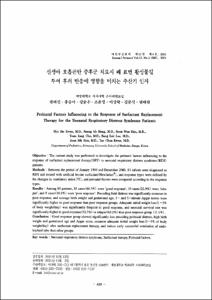신생아 호흡곤란 증후군 치료시 폐 표면 활성물질 투여 후의 반응에 영향을 미치는 주산기 인자
- Alternative Author(s)
- Lee, Sang Lak; Kim, Joon Sik; Kwon, Tae Chan
- Journal Title
- 대한주산의학회잡지
- ISSN
- 1229-2605
- Issued Date
- 2001
- Keyword
- Neonatal respiratory distress syndrome; Surfactant therapy; Perinatal factors; 신생아 호흡곤란 증후군; 폐 표면 활성물질; 주산기 인자
- Abstract
- Objective : The current study was performed to investigate the perinatal factors in-fluencing to the response of surfactant replacement therapy (SRT) in neonatal respiratory distress syndrome (RDS) patients.
Methods : Between the period of January 1999 and December 2000, 83 infants were diagnosed as RDS and treated with artificial bovine surfactant (Newfactan®), and response types were defined by the changes in ventilatory index (VI), and perinatal factors were compared according to the response types.
Results : Among 83 patients, 55 cases(66.3%) were ‘good response*, 19 cases(22.9%) were Rela¬pse*, and 9 cases(10.8%) were ‘poor response’. Preceding fetal distress was sig-nificantly common in poor response, and average birth weight and gestational age, 1— and 5—minute Apgar scores were significantly higher in good response than poor response groups. Adequate initial weight loss(1—3% of body weighl/day) was significantly frequent in good response, and neonatal survival rate was significantly higher in good response (92.7%) or relapse (63.2%) than poor response group (11.1%). Conclusion : Good response group showed significantly less preceding perinatal distress, high birth weight and gestational age and Apgar score,common adequate initial weight loss(1-3% of body weight/day) after surfactant replacement therapy, and induce early successful extubation of endo¬tracheal lube than other groups.
연구 목적: 신생아 호흡곤란 증후군(respiratory distress syndrome of newborn, RDS) 환아에서 폐 표면 활성물질 투여(surfactant replacement therapy, SRT)의 반응 양상과 어떠한 주산기 인자들이 폐 표면 활성물질 투여 후 반응에 영향을 미치는가를 알아보고자 하였다.
연구 방법 : 1999년 1월부터 2000년 12월까지 2년간 계명대학교 동산의료원 신생아 중환자실에 입원한 환아 중 임상직 및 방사선학적으로 RDS로 확진되어 Newfactan으로 SRT를 받은 환아 83례를 대상으로 하여 투여 후의 환기지표의 변화를 기준으로 한 치료 반응군을 양호군, 재발군 및 불량군으로 나누어 각 군의 발생 빈도와 주산기 인자 및 치료 결과를 비교분석하였으며 통계분석은 세 군간 비교는 ANOVA test, Kruskall-Wallis test 및 Pearson Chi-square test를 시행하였고, 두 군간의 비교는 Student t-test와 Chi-square test를 시행하였으며, 각각 p<0.05 인 경우 통계적으로 유의하다고 하였다.
결 과 ; 총 83례 중 양호군이 55례(66.3%), 재발군 19례(22.9%), 불량군 9례(10.8%)이었으며, 산전인자 중 태아 곤란증이 불량군에서 양호군이나 재발군 보다 의미있게 많았고, 평균 재태기간과 출생 체중은 양호군에서 재발군이나 불량균 보다 의미있게 높았으며 1분과 5분의 평균 Apgar 점수는 각각 불량군에서 양호군보다 의미있게 낮았다. 투여 전 RDS의 흉부 x-선 소견은 불량군에서 다른군보다 냐쁜 경우가 많았고, 투여 후의 첫 3일간의 일일 평균 체중변화는 양호군에서 재발군이나 불량군에서 보다 의미있게 체중감소가 일어났으며. 특히 양호군에서 더 적절한 일일 체중감소(체중의1∼ 3%/일)가 발생되었고 투여 후 기관내관의 발관이 가능하였던 환아의 평균 발관시기는 양호군에서 재발군과 불량군보다 의미있게 젊었으며, 신생아 생존율은 92.7%. 재발군 63.2%. 불량군 11.1%로 양호군과 재발군에서 불량군보다 의미있게높았다.
결 론 ; 이상의 결과로 SRT 후 양호한 반응을 보인 군이 다른 군보다 태아 곤란증이 적었고 평균 재태기간. 출생 체중과 Apgar 점수가 상대적으로 높았으며, 첫 3일간의 일일 평균 체중이 1-3% 적절히 감소되었다. 이들 양호군 에서 조기에 기관내관의 발관이 가능하게 되고 신생아생존율도 높일 것으로 생각되며 앞으로 이에 대한 더 많은 연구가 필요할 것으로 생각된다.
- Alternative Title
- Perinatal Factors Influencing to the Response of Surfactant Replacement
Therapy for the Neonatal Respiratory Distress Syndrome Patients
- Department
- Dept. of Pediatrics (소아청소년학)
- Publisher
- School of Medicine
- Citation
- 권혜진 et al. (2001). 신생아 호흡곤란 증후군 치료시 폐 표면 활성물질 투여 후의 반응에 영향을 미치는 주산기 인자. 대한주산의학회잡지, 12(4), 459–465.
- Type
- Article
- ISSN
- 1229-2605
- Appears in Collections:
- 1. School of Medicine (의과대학) > Dept. of Pediatrics (소아청소년학)
- 파일 목록
-
-
Download
 oak-bbb-3638.pdf
기타 데이터 / 1.48 MB / Adobe PDF
oak-bbb-3638.pdf
기타 데이터 / 1.48 MB / Adobe PDF
-
Items in Repository are protected by copyright, with all rights reserved, unless otherwise indicated.